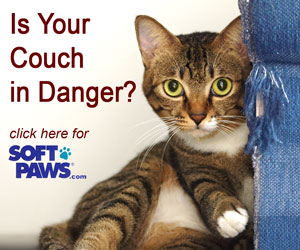Hyperthyroidism in Cats

Feline hyperthyroidism is a disorder that affects multiple systems in a cat's body. It is a common disease, and it can have devastating effects on a cat's health if it is left undiagnosed and untreated.
History of Feline Hyperthyroidism
Scientists first described this condition in the late 1970's, and the diagnosis of hyperthyroidism has steadily increased since that time.
Veterinarians are more aware of the disease and therefore diagnose it more often, but there is also suspicion that there are more cases today than 30 years ago.
Although plenty of time and resources have been devoted to studying feline hyperthyroidism, its cause is still elusive. Some believe that an imbalance of iodine in commercial cat foods or the exposure to environmental materials such as hydrocarbons (phenols, phthalates, etc.) potentially predispose humans and animals to thyroid diseases. You can learn more in these articles: "Flame Retardants and Hyperthyroidism in Cats," "Fishy Food and Feline Hyperthyroidism," and "Homemade Diets for Cats."
Others think that it is possible that hyperthyroidism in cats is caused by circulating immune system factors. Many hypotheses exist, but none have proven to be the single accepted reason why cats become affected by this disease.
What Is Hyperthyroidism in Cats?
Hyperthyroidism is the most common endocrine disease affecting middle-aged and older cats. Male and female cats are affected equally, as are all feline breeds.
Most cats have hyperthyroidism due to benign growths in their thyroid gland that increase the size of the gland (multinodular adenomatous hyperplasia) and its function. This results in an increase in the concentration of the thyroid gland hormones T3 and T4 in the cat's circulation. Although malignant thyroid tumors have been reported, they are rare and account for only 1-2 % of cats with hyperthyroidism.
Signs of Feline Hyperthyroidism
All of the clinical signs associated with hyperthyroidism are due to the increased amounts of T3 and T4, which generally have a stimulating effect (think cats on large amounts of coffee). Although there are many ways a cat with this disease can appear, most become very thin, and owners usually note a markedly increased appetite. The spike in appetite is due to the increased need for energy because of an accelerated metabolic rate.
Sadly, these cats cannot eat enough calories to sustain themselves. There have been reports of desperate cats attacking other pets in the family and even owners at the dinner table in an attempt to obtain more food.
Diseased cats can also be restless and nervous, vocal, display stumbling or weakness, have respiratory disease or heart arrhythmias, develop an unkempt and matted coat, experience vomiting and diarrhea, and exhibit excessive thirst and urination. Some cats will have an obviously enlarged thyroid gland (palpable goiter), but due to the hair coat and location of the gland lobes (next to the windpipe along the neck), this is something that owners rarely notice.
Over time, hyperthyroidism causes heart disease and high blood pressure in cats, which can both have devastating health effects.
Diagnosis of Hyperthyroid Disease in Cats
The diagnosis of feline hyperthyroidism is made by evaluating the cat's history and clinical signs, and it is confirmed with laboratory tests. Although other diseases can have signs similar to hyperthyroidism (diabetes, kidney disease, cancer, and chronic intestinal disease), some blood tests will help the veterinarian determine which disease or diseases are present. An increase in thyroid hormone levels in the blood of a cat that exhibits the clinical signs of hyperthyroidism is diagnostic for the disease.
Occasionally, cats with early, mild hyperthyroidism may have normal blood levels of T3 and T4. If the veterinarian still suspects the disease, a second blood test should be taken a few weeks later, due to the fluctuation of the hormones in and out of the normal range in the early stage of the disease. Other tests exist to deny or confirm the diagnosis of hyperthyroidism (radioiodine uptake and diagnostic scanning, T3 suppression testing, and TRH response testing). These are less commonly used.
A free T4 by equilibrium dialysis is a specific blood test that can often help diagnose hyperthyroidism when the T4 is still in the normal range, so your veterinarian may also recommend that test.
The veterinarian will screen for general health of the cat, especially for the presence of kidney disease, heart disease, and high blood pressure.
Treatment of Feline Hyperthyroidism
Treatment of hyperthyroidism in cats usually has good results and is aimed at reducing functioning thyroid hormone levels. There are 3 ways this goal may be accomplished. Your veterinarian is best suited to help you decide which treatment is best for your cat based on a number of factors.
- An oral medication, methimazole, may help to bind excess thyroid hormone. They are not a cure for hyperthyroidism, and they will need to be used for the rest of the cat's life. Complete blood counts and T4 levels should be checked regularly during the first 3 months of therapy with oral medications. It is important to use the lowest possible effective dose. Some cats will have side effects from this drug including vomiting and weakness, low platelet counts, anemia, extreme facial itchiness, and severe liver disease. These cats may not be candidates for medical therapy.
- Anti-thyroid medications can be compounded into other forms for cats that don't take pills well. The most common of these is a transdermal gel which is placed, using gloves, on the skin of the inner ear pinna. The absorption of this formulation can vary quite widely among cats; for some it may work as well as taking the drug orally, while others may not respond to it at all, and all points in between. Many veterinarians prefer to start with the oral form to get the cat's thyroid hormones regulated, then switch to the transdermal with close monitoring of how the levels respond. It may also be possible to start right off on the transdermal form of the drug, but the owner must understand that it might not work well enough.
- Thyroidectomy, or surgical removal of part of the thyroid gland, can be performed by some general veterinarians and by veterinary surgical specialists. There are not many disadvantages to surgical removal of the thyroid. However, if the patient is of advanced age or in a debilitated condition, surgery and anesthesia will be riskier. If vessels, nerves, or the parathyroid glands, which inhabit the area of the thyroid gland, are affected during surgery, side effects will occur. Parathyroid gland parameters are carefully monitored by the health care team after surgery, and prompt treatment is instituted if the function is compromised. Although rare, some cats that undergo thyroidectomy may relapse into hyperthyroidism a few years after the surgical procedure due to re-growth of the nodules of the thyroid lobes. However, surgery has the benefit of usually being curative and if successful, releases the owner from the need to medicate the cat on a daily basis.
- Administration of radioiodine is the third option for treatment of feline hyperthyroidism. This method of treatment has several advantages over the others. It avoids the hassle of daily oral medications and the potential side effects of anti-thyroid drugs, and it is without the risks of anesthesia for surgical thyroidectomy. The major drawbacks of this type of treatment are the cost, the lack of widely available facilities that can perform the procedure, and the need for the cat to be confined to a restricted area of the hospital for a short term. It used to be that, for 1 to 3 weeks after treatment, the cat would need to be restricted to the area, but newer regimens allow for quick return to the caregiver in many treatment facilities. Most experts recommend avoiding close, prolonged contact with the treated cat or the urine and feces during the first 2 weeks that they are home.
- Hill's Science Diet now produces a hyperthyroid diet called y/d. This is a prescription feline diet that is intentionally iodine deficient. The idea is that, because iodine is used to produce T3 and T4, feeding an iodine deficient diet may reduce those circulating hormone levels and relieve the signs of hyperthyroidism. Since iodine deficiency is one suspected cause of hyperthyroidism, feeding such a diet, while it may decrease the disease's signs, may encourage the growth of the responsible thyroid growths. Y/d is also fairly low in protein and contains soy, which has also been implicated as a thyroid disruptor. There are concerns that y/d may not treat hyperthyroidism as effectively as other methods, including supporting and increasing kidney function. If y/d is used as a therapy for hyperthyroidism, it's important that the cat not receive any other type of food at all, so it can be a challenge to pull off in multi-cat households. The food should not be given along with medication or other treatment for hyperthyroidism because the thyroid levels may then become too low. There is a need for more objective studies to be done on y/d and its long-term results, but it may be a good fit for cats that don't take medications well and aren't candidates for other treatment methods. As stated above, your veterinarian is best suited to help you evaluate which form of thyroid treatment is best for your individual cat.
Prognosis for Hyperthyroidism in Cats
Whatever method of treatment the health care team decides to pursue for a hyperthyroid cat, the outcome is usually highly rewarding. Most cats can be brought back to health, and even serious consequences of the disease such as heart dysfunction can often be reversed with proper treatment. Concurrent kidney disease can pose special challenges, but your veterinarian will advise you of the preferred course of action.
If you suspect that your cat might be suffering from this condition, consultation with the family veterinarian to develop a plan for diagnosis and treatment is necessary.
You May Also Like These Articles:
Ethoxyquin, Mercury, and PCBs: Is Feeding Fish Safe for Cats?
Human Medications That Are Dangerous to Cats
Top 10 Cat Toxins of 2014 - Slideshow
Sago Palms Can Be Lethal to Cats
Warning: Topical Medications Containing Flurbiprofen May Be Dangerous to Cats
Notice: Ask-a-Vet is an affiliated service for those who wish to speak with a veterinary professional about their pet's specific condition. Initially, a bot will ask questions to determine the general nature of your concern. Then, you will be transferred to a human. There is a charge for the service if you choose to connect to a veterinarian. Ask-a-Vet is not manned by the staff or owners of CatHealth.com, and the advice given should not delay or replace a visit to your veterinarian.






